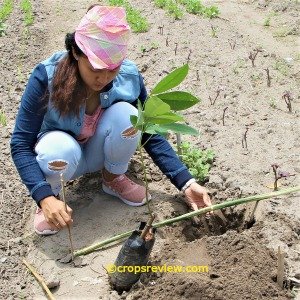Budding, often called bud grafting, is an artificial method of asexual or vegetative propagation in plants.
Like grafting, this method is employed to convert one plant (the rootstock) into another plant type with desirable characteristics.
Similarly, the resulting plants, in general, have shortened stature and maturity as compared to plants propagated from seed.
This method of plant propagation has the advantage of producing numerous clones from a single piece of stem or twig, each node being a potential source of the one-budded scion.
But in grafting, this same piece of the stem may account for only a single scion.
It is therefore advantageous where there is a limited source of plant cuttings or scions for grafting.
Likewise, the necessity of transporting bulky scions is eliminated.
However, the clones produced take a longer time to develop into the right sizes for outplanting than grafted seedlings.
Various techniques are used, mostly applicable to young plants in active growth with stems in which the bark is easily separable from the wood.

Budding Procedure
Basically, the procedure in budding consists of the following steps:
1. Preparation of the rootstock
Rootstocks about the size of an ordinary pencil (~0.8cm) and up to ~1.5 cm in diameter are commonly used but there are no hard rules.
Chip budding is applied in citrus ~1/2 cm or 5mm in diameter while other methods can apply to rootstocks up to ~2.5cm (1 in) or even thicker.
Potted seedlings are widely used but, similar to grafting, established trees may be top-budded.
The specific techniques used in preparing the portion of the stem where the union is intended vary.
2. Preparation of the bud-scion
This consists of a prominent axillary bud (a plant organ that serves as a growing point) on a section of bark, with or without a small piece of wood attached.
This piece of bark is often termed as either a bud patch, chip, or shield piece. They are also referred to as single-bud scions.
Budsticks, small stems or twigs having multiple nodes from which the bud-containing barks are to be prepared, are obtained from well-selected vigorous, disease-free mother plants having desirable characteristics and immediately defoliated.
As in rootstocks, the preparation techniques are numerous;
3. Insertion of the prepared bud-scion
The prepared patch, chip, or shield piece is inserted into the part of the stem of the rootstock to replace the piece of bark that is removed or where cuts are made to allow the union.
Correct polarity should be observed, that is, the patch of bark is oriented upward.
4. Tying or wrapping
The stem-bud union is tied or wrapped to hold the components firmly together but generally leaves the growing point exposed.
If also wrapped, it must be opened about 15 days later or at the time when the rootstock is cut back.
There are various ready-to-use wrapping materials.
A specialized wrapping strip made of rubber expands as the rootstock grows and naturally deteriorates after several weeks.
But for practical usage, a thin, transparent polypropylene (PP) plastic bag can be cut into strips about 2-3 cm wide.
These plastic strips have to be elastic and do not easily break when stretched.
5. Cut back of the rootstock
The rootstock must be decapitated, preferably with the use of a pruning shear, at the part of the stem immediately above the union to eliminate apical dominance.
As a result, a new shoot will emerge from the growing point on the inserted bark which will then acquire apical dominance.
Cut back is done when it becomes certain that there is a union which may take 15 days or more.
The inserted patch of bark will remain green or otherwise brownish depending on the natural color of the budstick.
If the union is not successful, it will turn black and rot.
6. Care of clones
This involves activities that are normally performed to hasten the rapid growth of nursery plants and trees.
It also includes debudding and desuckering, the removal of offshoots that may emerge from the stem below the union.
These are done to ensure that the propagated plants will exhibit only the characters of the mother plant.
Likewise, wrapping materials that take time to deteriorate, like PP plastic strips, must be removed at the earliest time possible to prevent the strangling effect.


Can I use bud of a citrus tree that is already bud grafts to bud all my rootstock to get the same variety